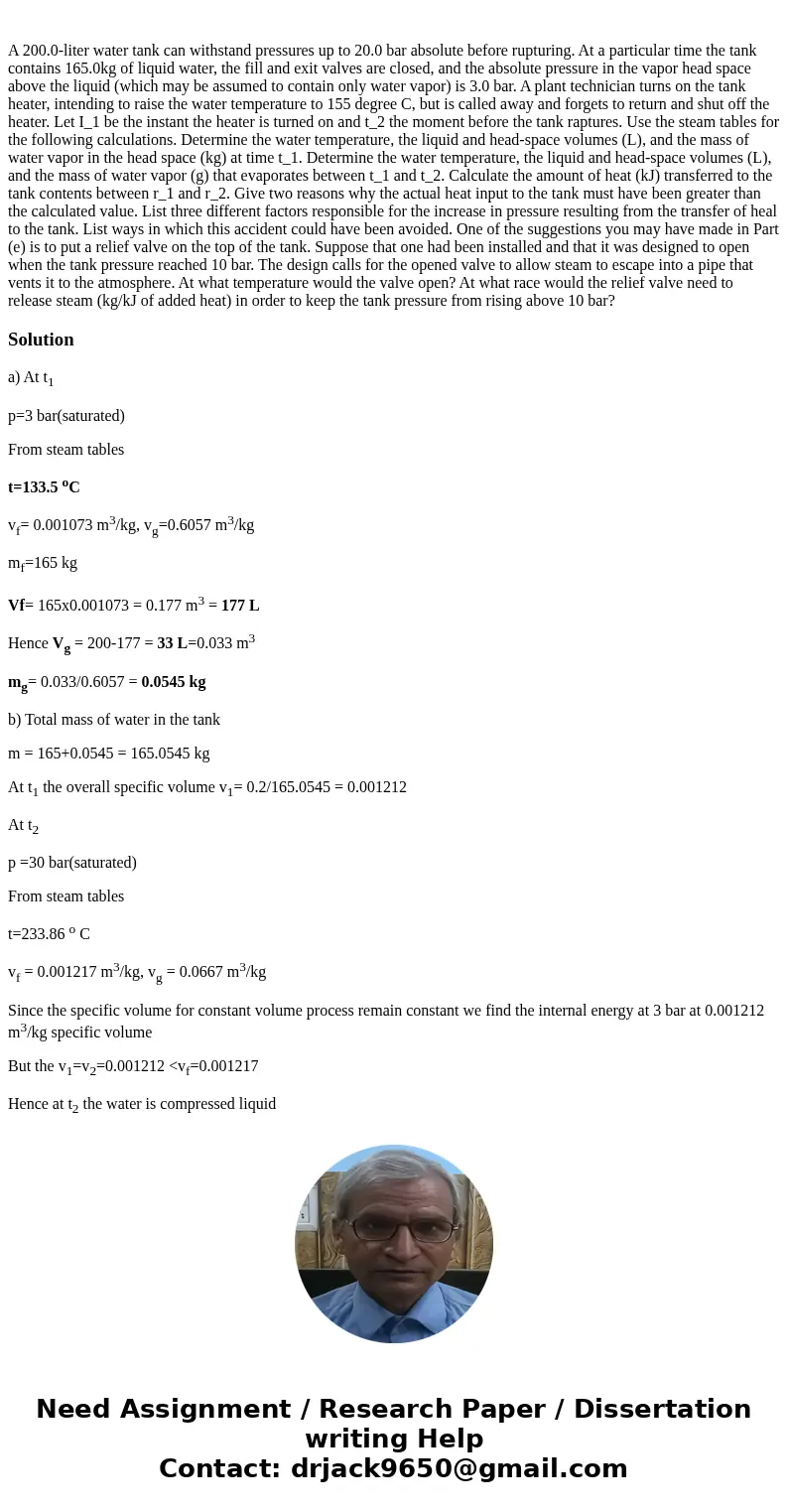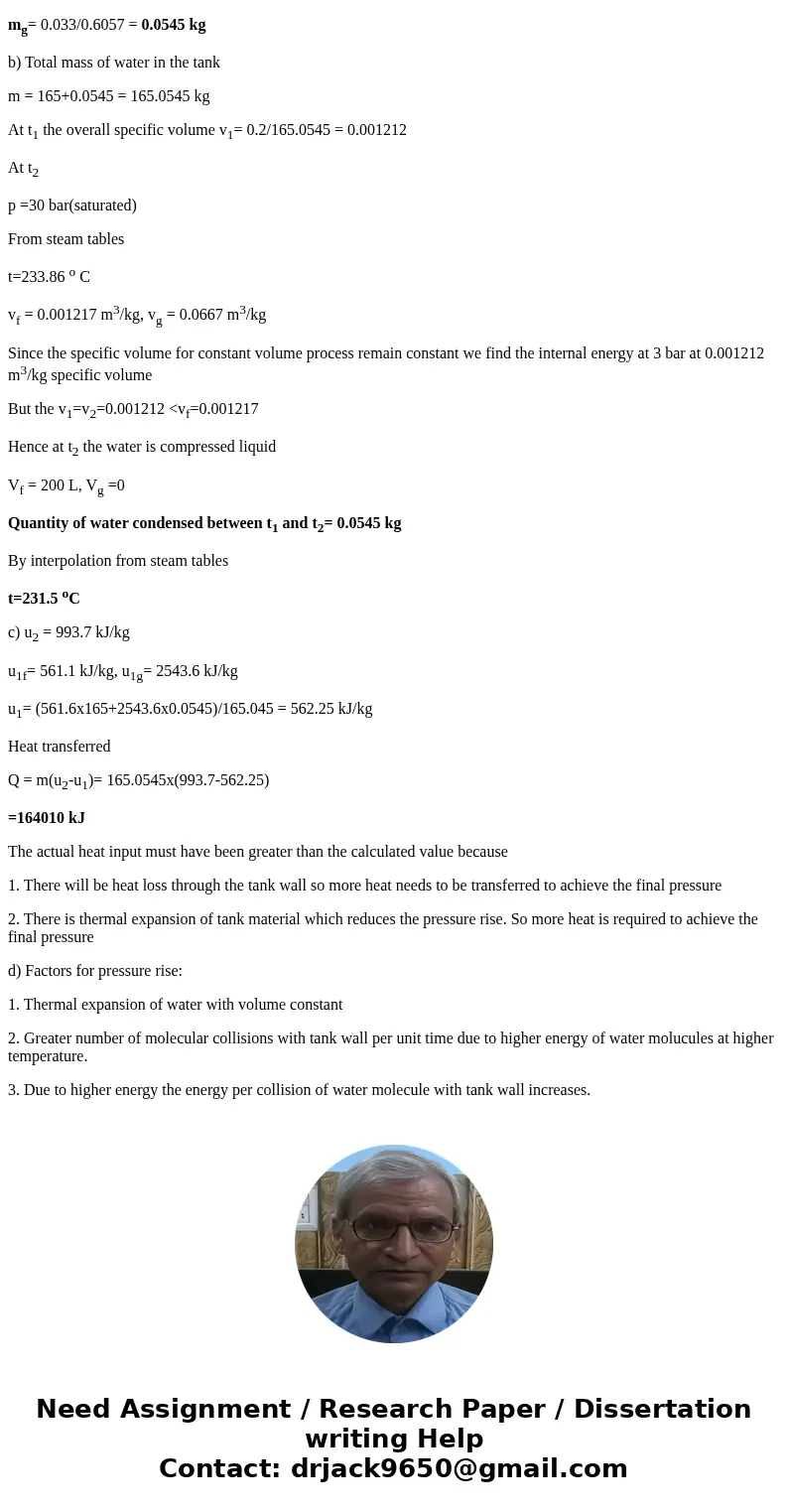A 200.0-liter water tank can withstand pressures up to 20.0 bar absolute before rupturing. At a particular time the tank contains 165.0kg of liquid water, the fill and exit valves are closed, and the absolute pressure in the vapor head space above the liquid (which may be assumed to contain only water vapor) is 3.0 bar. A plant technician turns on the tank heater, intending to raise the water temperature to 155 degree C, but is called away and forgets to return and shut off the heater. Let I_1 be the instant the heater is turned on and t_2 the moment before the tank raptures. Use the steam tables for the following calculations. Determine the water temperature, the liquid and head-space volumes (L), and the mass of water vapor in the head space (kg) at time t_1. Determine the water temperature, the liquid and head-space volumes (L), and the mass of water vapor (g) that evaporates between t_1 and t_2. Calculate the amount of heat (kJ) transferred to the tank contents between r_1 and r_2. Give two reasons why the actual heat input to the tank must have been greater than the calculated value. List three different factors responsible for the increase in pressure resulting from the transfer of heal to the tank. List ways in which this accident could have been avoided. One of the suggestions you may have made in Part (e) is to put a relief valve on the top of the tank. Suppose that one had been installed and that it was designed to open when the tank pressure reached 10 bar. The design calls for the opened valve to allow steam to escape into a pipe that vents it to the atmosphere. At what temperature would the valve open? At what race would the relief valve need to release steam (kg/kJ of added heat) in order to keep the tank pressure from rising above 10 bar?
a) At t1
p=3 bar(saturated)
From steam tables
t=133.5 oC
vf= 0.001073 m3/kg, vg=0.6057 m3/kg
mf=165 kg
Vf= 165x0.001073 = 0.177 m3 = 177 L
Hence Vg = 200-177 = 33 L=0.033 m3
mg= 0.033/0.6057 = 0.0545 kg
b) Total mass of water in the tank
m = 165+0.0545 = 165.0545 kg
At t1 the overall specific volume v1= 0.2/165.0545 = 0.001212
At t2
p =30 bar(saturated)
From steam tables
t=233.86 o C
vf = 0.001217 m3/kg, vg = 0.0667 m3/kg
Since the specific volume for constant volume process remain constant we find the internal energy at 3 bar at 0.001212 m3/kg specific volume
But the v1=v2=0.001212 <vf=0.001217
Hence at t2 the water is compressed liquid
Vf = 200 L, Vg =0
Quantity of water condensed between t1 and t2= 0.0545 kg
By interpolation from steam tables
t=231.5 oC
c) u2 = 993.7 kJ/kg
u1f= 561.1 kJ/kg, u1g= 2543.6 kJ/kg
u1= (561.6x165+2543.6x0.0545)/165.045 = 562.25 kJ/kg
Heat transferred
Q = m(u2-u1)= 165.0545x(993.7-562.25)
=164010 kJ
The actual heat input must have been greater than the calculated value because
1. There will be heat loss through the tank wall so more heat needs to be transferred to achieve the final pressure
2. There is thermal expansion of tank material which reduces the pressure rise. So more heat is required to achieve the final pressure
d) Factors for pressure rise:
1. Thermal expansion of water with volume constant
2. Greater number of molecular collisions with tank wall per unit time due to higher energy of water molucules at higher temperature.
3. Due to higher energy the energy per collision of water molecule with tank wall increases.


 Homework Sourse
Homework Sourse